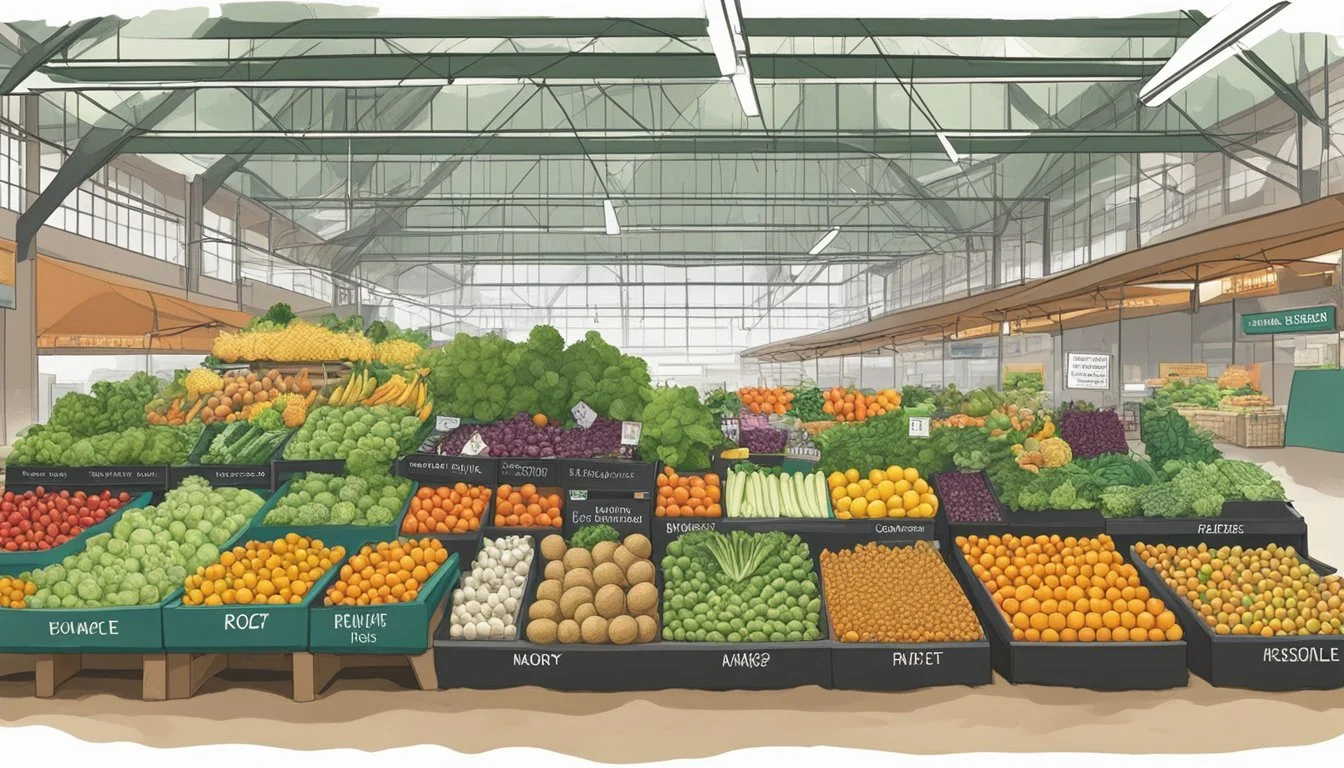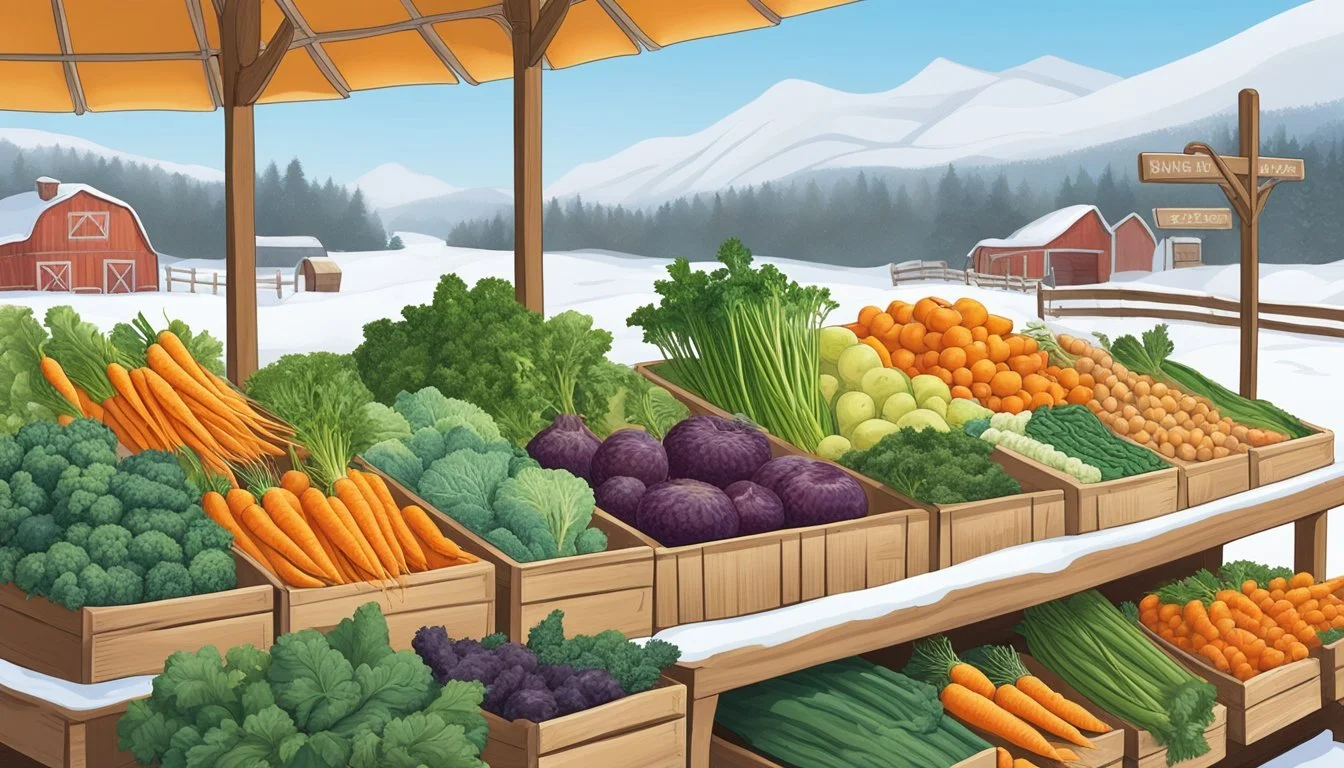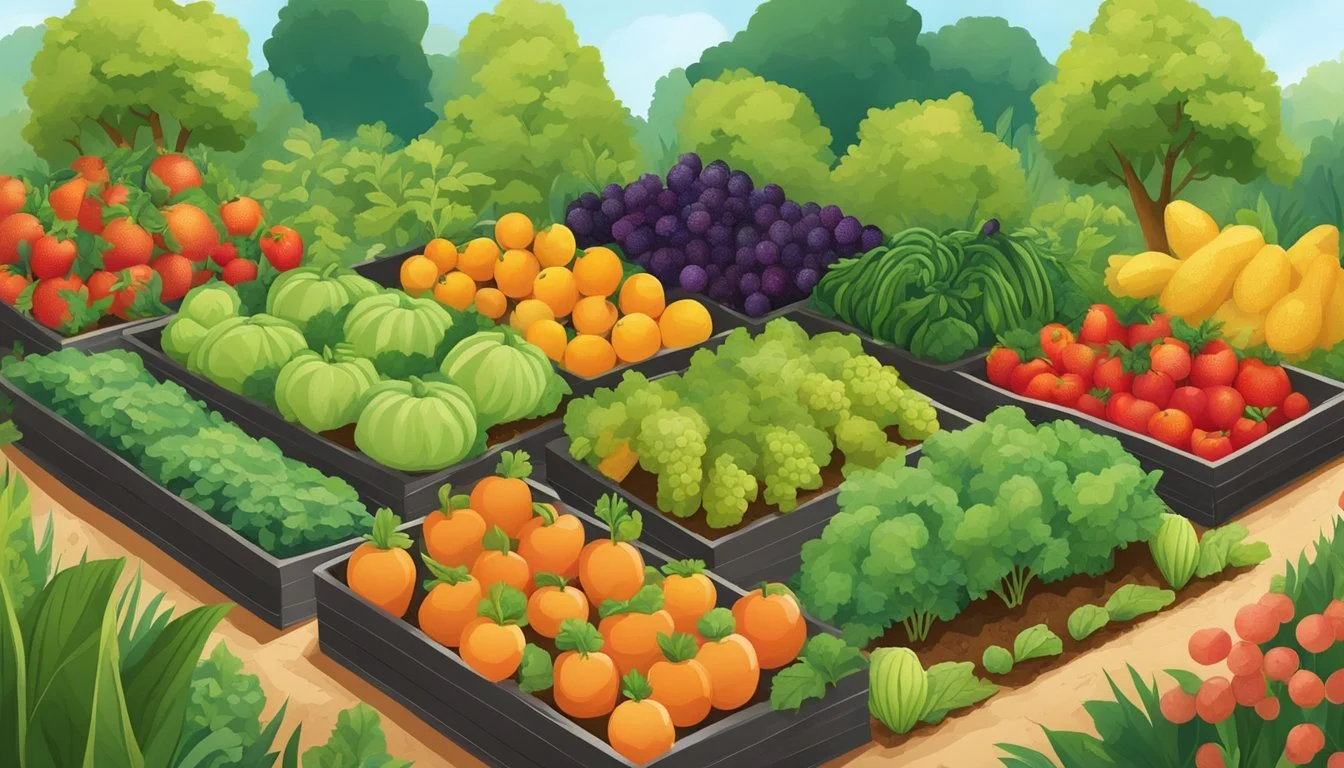Mississippi Seasonal Fruit & Vegetables in January
Your Fresh Guide
This Article is Part of our Mississippi Seasonal Fruit & Veg Calendar
In Mississippi, January marks a period where the selection of fresh produce is distinct from the bountiful harvests of the warmer months. Despite the chill of winter, local farmers and markets continue to offer a variety of seasonal fruits and vegetables. The advantage of consuming produce that is in season not only guarantees peak freshness and flavor but also supports the local economy and promotes sustainable agricultural practices.
Mississippi's winter climate still allows for the growth of certain hardy vegetables and fruits. Root vegetables such as sweet potatoes and turnips thrive in colder temperatures, storing energy in their roots and offering rich nutrients. Greens like kale and collards are also more robust against the frost, often becoming sweeter after a cold snap. Meanwhile, citrus fruits such as oranges and grapefruits reach their juicy ripeness during the winter months.
While the variety of available produce in January may be less than in the peak seasons, the options provided are still valuable additions to the diet. They embody the resilience of local agriculture and offer a taste of Mississippi's seasonal rhythms. Buying seasonal fruits and vegetables during this month ensures consumers are getting the most flavorful and nutrient-dense produce while also reducing their carbon footprint by relying on locally sourced and timely-harvested goods.
Understanding Mississippi's Climate Zones
Mississippi's diverse climate zones significantly affect the growth and cultivation of fruits and vegetables. These zones dictate the appropriate planting times and the range of plants that can thrive during the winter months, particularly in January.
Zone Identification and Its Impact on Growth
Mississippi is divided into five main planting zones: Zones 1 through 5. The United States Department of Agriculture (USDA) has established these zones based on the average annual minimum winter temperature. Each zone has a range of minimum temperatures:
Zone 1: -60 to -50°F
Zone 2: -50 to -40°F
Zone 3: -40 to -30°F
Zone 4: -30 to -20°F
Zone 5: -20 to -10°F
However, these zones do not typically correlate directly with Mississippi's climate, which is generally milder. Within Mississippi, the climate zones range from 7a to 9a, indicating milder winter temperatures. Zone 5, the coldest zone in Mississippi, experiences minimum temperatures ranging from -20 to -10°F. Plants in Mississippi must be suited to these specific zones to ensure that they can survive and grow during the winter season.
Winter Weather Patterns in Mississippi
In January, Mississippi's weather exhibits cold, but relatively mild winter conditions compared to more northern states. The state does not experience extreme cold temperatures seen in higher USDA zones, and January in Mississippi falls under the humid subtropical climate classification. This creates a unique set of challenges and opportunities for growing seasonal fruits and vegetables.
While the southern regions of Mississippi, correlating to Zones 8 and 9, rarely see extreme cold, the northern regions can experience chillier weather. Gardeners in these colder zones, including Zone 5, must be cautious with their plant selection for January, ensuring they are hardy enough to withstand any cold snaps. Winter weather patterns can vary, and a mild winter day can quickly turn into a freeze, which is especially relevant for delicate plant varieties.
Understanding and preparing for these weather patterns is crucial for successful cultivation of winter produce in Mississippi.
Seasonal Produce Available in January
January in Mississippi brings forth a bounty of hearty vegetables that thrive in cooler weather. These seasonal offerings provide robust flavors and essential nutrients to the winter diet.
Root Vegetables Harvest
Root vegetables reach prime ripeness during January. Mississippi's soil nourishes a selection of these subterranean treasures, with sweet potatoes and turnips standing out for their versatility in the kitchen. Both can be roasted, mashed, or added to stews for a comforting winter meal. Carrots and parsnips also peak this month, offering a sweet, earthy taste to a variety of dishes.
Mississippi Root Vegetables in January:
Sweet Potatoes
Turnips
Carrots
Parsnips
Leafy Greens Availability
Leafy greens like spinach and kale are abundant in Mississippi during January. These greens are not only versatile for cooking—they can be sautéed, added to salads or smoothies—but they are also packed with vital vitamins and minerals. Their robust nature allows for continued harvests, even in the cooler temperatures of winter.
Mississippi Leafy Greens in January:
Spinach
Kale
Cruciferous Vegetables in Season
The cruciferous family of vegetables, which includes broccoli (how long does broccoli last?)and cauliflower (how long does cauliflower last?), are in full swing in January. These nutrient-dense vegetables are known for their cancer-fighting properties and can be prepared in numerous ways, such as steamed, roasted, or included in casseroles. Brussels sprouts (how long do brussels sprouts last?)are another cruciferous vegetable available at this time, perfect for roasting to a caramelized finish.
Mississippi Cruciferous Vegetables in January:
Broccoli
Cauliflower
Brussels Sprouts
By incorporating these seasonal vegetables into the diet, Mississippi residents can enjoy fresh, flavorful, and nutritious produce even in the midst of winter.
Planning and Planting for Spring and Summer
January serves as a preparatory month for Mississippi gardeners who are gearing up for the spring and summer seasons. It's a critical time to plan and initiate the planting of various cool-season vegetables, as well as prepare the groundwork for the warm-season crops that follow.
Cool-Season Vegetables Planting Guide
In January, Mississippi gardeners should focus on planting cool-season vegetables that can withstand the milder temperatures of spring. Vegetables such as broccoli, cauliflower, and cabbage can be planted during this time for a bountiful spring harvest. Specifically, carrots are often sowed between January 20 and January 29. Gardeners can utilize a staggered planting approach, spacing out the sowing dates to extend the harvest period and ensure a continuous supply of fresh produce.
Planting Dates for Selected Cool-Season Vegetables:
Carrots: January 20 - January 29
Cauliflower: Start with plants as early as February 1
Broccoli: Follow similar early February dates using transplants
Preparing for Warm-Season Vegetable Garden
While the soil remains cool, January is also a strategic month for Mississippi gardeners to plan their warm-season vegetable gardens. They should begin to prepare the soil by enriching it with compost and other organic matter, ensuring a fertile environment for vegetables like tomatoes, peppers, and sweet corn which are typically planted from mid-spring to mid-summer. By May and June, the garden should be ready to support these sun-loving crops. Gardeners should chart out their garden to maximize space and sunlight, considering the height and spread of each prospective plant.
Key Tasks for Warm-Season Vegetable Preparation:
Enrich soil with compost and organic matter in January.
Plan the garden layout based on the sun's trajectory and the space each plant will need.
Begin sowing warm-season vegetables like tomatoes and peppers in May and June.
Mississippi gardeners can ensure success by adhering to these specific timelines and preparation strategies for their spring and summer gardens.
Culinary Uses and Nutrition
In Mississippi, January's cooler climate yields hearty vegetables like cabbage and an array of leafy greens, which are not only versatile in the kitchen but also packed with nutrients. These seasonal offerings inspire wholesome dishes and can be preserved for ongoing enjoyment.
Healthy Winter Recipes with Seasonal Produce
Cabbage and lettuce are staples of the winter produce selection in Mississippi, offering a fresh, sweet flavor and numerous nutritional benefits. Cabbage, rich in vitamins C and K, can be transformed into a warming soup or a vibrant slaw. Lettuce, while often seen in salads, can also be braised or added to soups for a touch of sweetness and is a notable source of vitamin A and potassium.
Peas: Fresh peas, available in January, bring sweetness and a pleasing texture to dishes. They are excellent in stews and pair well with winter squashes.
Squash: This gourd contributes a comforting note to winter meals, filled with fiber and vitamin A.
Here's a brief overview of how one can feature these vegetables in recipes:
Cabbage: Shredded in salads, braised with apples, or as a vessel for stuffed cabbage rolls.
Lettuce: Crispy salads, as wraps, or gently wilted in stews.
Peas: Blended into soups, mixed into risottos, or added to pasta for a pop of sweetness.
Sweet Corn: An unexpected winter delight when preserved, adding sweetness and crunch to chowders and fritters.
Preserving Techniques for Off-Season Enjoyment
With an eye towards future months, these seasonal vegetables can be stored through techniques such as freezing which locks in flavor and nutrients.
Freezing: Ideal for sweet corn and peas, blanching before freezing preserves their sweet flavor and the integrity of their texture.
Cabbage: It can be fermented to create sauerkraut (how long does sauerkraut last?), extending its shelf life significantly.
The following are common methods of preservation:
Sweet Corn: Blanch ears of corn briefly in boiling water, then cut off the kernels and freeze in a single layer before transferring to bags or containers.
Peas: Pod, blanch, and freeze on a baking sheet, then store in airtight containers or freezer bags.
Lettuce: Although not commonly frozen, lettuce can be kept in the refrigerator, with roots attached in a container of water to extend its freshness.
Mississippi's January produce like cabbage and sweet corn can continue to impart their robust flavors and nutritional benefits well beyond their peak season through these simple, effective preservation methods.
Gardening Tips and Best Practices
In Mississippi, January is a month of preparation for gardeners. Focusing on soil quality and the right selection of seeds is crucial for a successful vegetable garden.
Soil Preparation and Maintenance During Winter
Gardeners should ensure the soil is well-amended and ready for planting. In January, this often involves:
Testing: They must test the soil to determine pH levels and nutrient deficiencies.
Amending: Based on these results, they should incorporate compost or other organic matter to enhance soil fertility and structure.
Protection: Covering the soil with mulch or a cover crop can protect it from erosion and nutrient leaching caused by winter rains.
Selection of Seeds and Seedlings for January Planting
Mississippi gardeners should:
Choose Hardy Vegetables: Opt for seeds and seedlings that can withstand cooler temperatures. Vegetables like leafy greens (lettuce and spinach) and root vegetables (turnips) can be sown in January.
Consider Container Gardening: For seeds that prefer a warmer start, gardeners may use containers indoors to control temperature and moisture.
By adhering to these tips, they lay a strong foundation for a fruitful vegetable garden.
Economic and Community Impact
Mississippi's seasonal fruits and vegetables in January have a significant role in bolstering both the state's economy and community engagement. By understanding how local markets and seasonal availability interact with the larger agricultural economy, one can appreciate the value that this sector brings to the region.
Local Markets and Seasonal Availability
In January, local markets in Mississippi often offer a variety of seasonal produce that includes winter greens, sweet potatoes, and a selection of greenhouse-grown items. These markets not only provide consumers with fresh produce during the colder months but also serve as social hubs, strengthening community bonds. It is through these venues that residents gain access to fresh, locally-sourced goods, supporting the concept of farm-to-table within their cities.
Typical January Produce:
Greens (kale, collards)
Sweet potatoes
Greenhouse-grown produce (tomatoes, cucumbers)
Supporting Mississippi's Agricultural Economy
The state's agricultural sector benefits from the sales of these seasonal products. Mississippi's economy sees an injection of capital through both direct sales at local markets and indirect spending in related sectors. Furthermore, the agricultural economy receives a boost from consumers who prioritize buying locally, thereby keeping more money within the state.
Economic Data:
Agriculture and forestry contribute significantly to Mississippi’s economy.
Local food sales help sustain jobs and income for Mississippians.
By understanding the dual impact of local marketplace dynamics and their contribution to Mississippi's agricultural economy, one can see the valuable role that seasonal produce plays during January and throughout the year.
Additional Resources
In Mississippi, finding the right time to harvest or buy fresh produce can be greatly aided by updated local resources. These resources provide invaluable data and expertise specific to the state's diverse climate zones, ensuring gardeners and consumers have access to the most accurate information available.
State Agricultural Extensions and Guides
Mississippi State University Extension Service is a treasure trove of information, offering detailed guides and tools that are indispensable for understanding regional planting and harvesting times. Gardeners can access a broad range of research-based knowledge, including:
Planting dates
Cultivation tips
Pests management strategies
Additionally, the Department of Agriculture and Commerce provides current data and resources through its various programs aimed to support local agriculture and market development.
Interactive Maps for Seasonal Eating
Interactive maps are fantastic tools for consumers looking to eat seasonally and locally. They usually represent a handy visual guide reflecting:
Seasonal Availability: Precise harvest times per fruit and vegetables in Mississippi.
Local Farmers' Markets: Locations where one can purchase fresh, in-season produce directly from growers.
These maps are often state-sponsored, providing the latest data to support both residents and farmers in making informed decisions.







